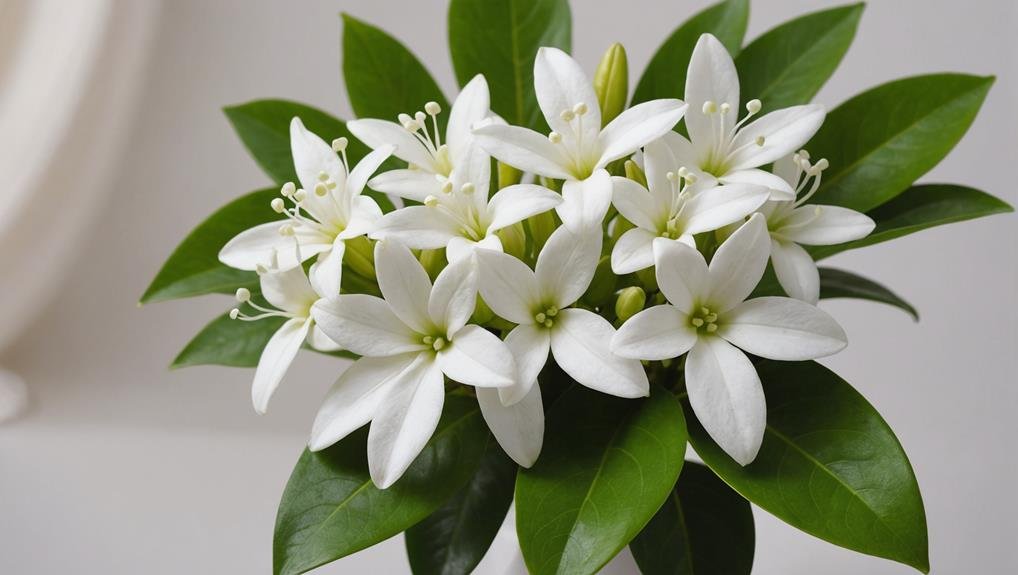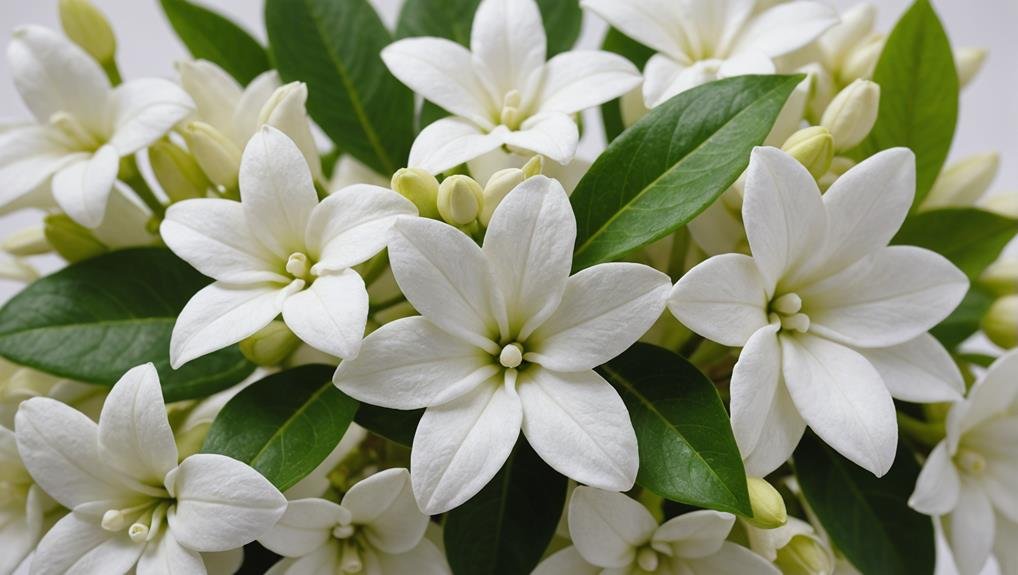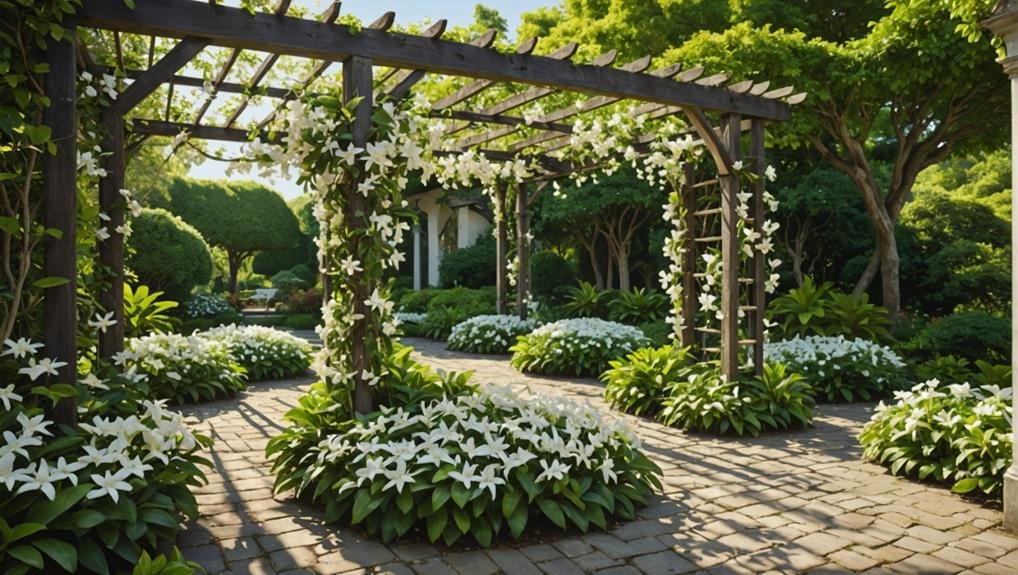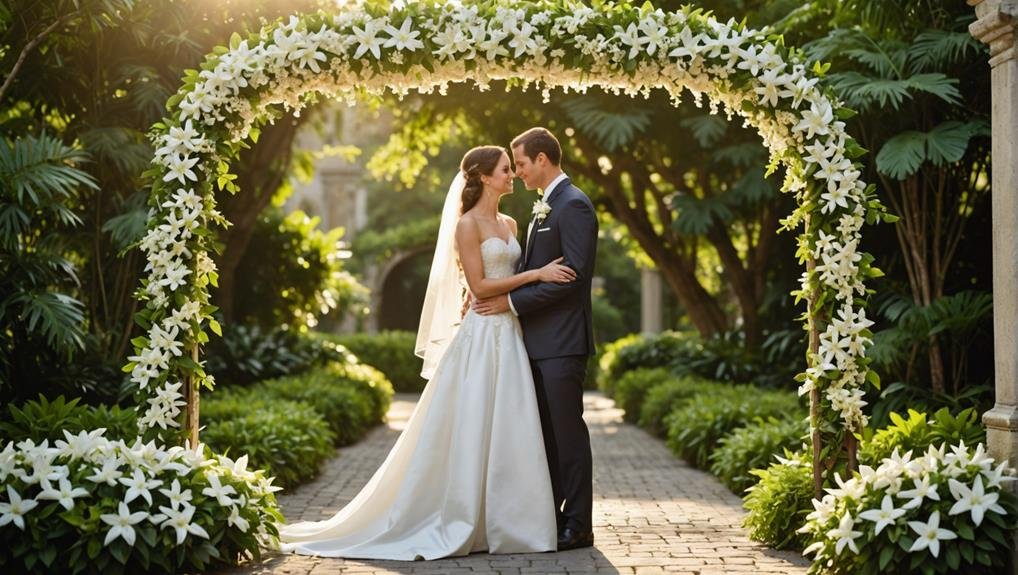In the domain of wedding florals, Stephanotis holds a place of timeless elegance and profound symbolism. Known for its star-shaped, waxy white blooms and enchanting fragrance, this flower has been cherished in bridal bouquets and hair arrangements for generations. Often referred to as the 'wedding plant,' Stephanotis embodies joy and prosperity, making it an ideal choice for those seeking to infuse their ceremony with a touch of classic sophistication. But what makes this delicate bloom truly stand out in the world of wedding flowers? Let us explore its unique attributes and deeper cultural significance.
Flower Overview

The Stephanotis plant, renowned for its starry white blooms and potent fragrance, is a quintessential choice for wedding bouquets, symbolizing marital happiness. The appeal of Stephanotis in wedding ceremonies is multifaceted. Its dainty, waxy flowers are not only visually engaging but also exude a delicate perfume that enhances the bridal bouquet's overall charm.
Known colloquially as the 'wedding plant,' Stephanotis has earned its place in nuptial traditions across cultures due to its symbolic representation of joy and prosperity in marriage.
In addition to its primary use in bridal bouquets, Stephanotis flowers are also frequently incorporated into brides' hair arrangements. This practice adds a touch of elegance and continuity to the bridal look, seamlessly blending the floral theme. The symbolic meaning of these flowers elevates their importance, providing an added layer of significance to wedding ceremonies.
The inedible fruit of the Stephanotis plant, resembling a mango, is less commonly utilized in wedding decor, but it is remarkable for its unique appearance and the seeds it releases, which are adorned with silky, filament-like hairs.
Physical Description
Beyond its symbolic significance in weddings, Stephanotis captivates with its distinctive physical attributes. Known for its highly fragrant, waxy white blooms, this vine plant is a popular choice for wedding bouquets and bridal adornments. The star-shaped flowers of Stephanotis are not only visually appealing but also emit a delightful fragrance that enhances their allure. These flowers, often referred to as the 'wedding plant', symbolize marital happiness, making them a quintessential choice for matrimonial ceremonies.
The Stephanotis vine is characterized by its glossy, dark green leaves that provide a striking contrast to its pristine white flowers. Typically, the plant produces clusters of these blooms, each measuring about one inch in diameter. The flowers are tubular with a slightly flared, star-like shape that adds to their charm and elegance.
Here are some key physical attributes of Stephanotis:
- White Blooms: The star-shaped, waxy white flowers are highly fragrant and visually striking.
- Vine Structure: The plant grows as a vine, often requiring support, making it ideal for cascading bouquets.
- Glossy Leaves: The dark green, glossy leaves complement the white flowers, enhancing the plant's overall appeal.
These features make Stephanotis a cherished addition to wedding decor.
Available Colour Varieties

Stephanotis flowers mainly exhibit a classic white hue, symbolizing purity and innocence in wedding ceremonies. This timeless elegance makes them a popular choice for traditional weddings. The pristine white color of Stephanotis blooms offers a versatile option that pairs seamlessly with almost any other flower color, enhancing the overall aesthetic of bridal bouquets and floral arrangements.
While white is the predominant color, Stephanotis flowers can occasionally exhibit slight variations in hue. Some blooms may appear with a subtle ivory or cream tint, adding a delicate touch of sophistication to the arrangement. These slight variations can provide a gentle contrast, enriching the visual appeal of the floral display.
In addition to their natural shades, florists sometimes offer dyed Stephanotis flowers to cater to unique wedding themes and preferences. By introducing various shades through dyeing, couples can achieve personalized and distinctive floral arrangements that align with their wedding color schemes. However, the classic white Stephanotis remains a favored option due to its symbolic significance and unmatched versatility.
Latin Name and Taxonomy
Stephanotis floribunda, commonly known as Madagascar Jasmine, belongs to the Apocynaceae family. This exquisite vine is highly regarded in botanical circles and cherished for its elegant, fragrant white flowers, which make it a popular choice for weddings and other special occasions.
The Latin Name, Stephanotis floribunda, reflects the plant's remarkable characteristics. The genus name, Stephanotis, is derived from the Greek words 'stephanos,' meaning crown, and 'otis,' meaning ear, symbolizing the flower's crown-like appearance. Floribunda, the species name, indicates the plant's abundant blooming nature, as it produces a multitude of flowers.
In terms of taxonomy, Stephanotis floribunda can be classified as follows:
- Kingdom: Plantae
- Family: Apocynaceae
- Genus: Stephanotis
Stephanotis floribunda is a medium-sized vine, native to Madagascar, and has become a beloved addition to gardens and interior spaces worldwide due to its decorative appeal and enchanting fragrance. Its botanical significance is further highlighted by its frequent use in wedding bouquets and floral arrangements, where it symbolizes marital happiness and good luck.
Understanding the Latin Name and taxonomy of Stephanotis floribunda allows us to appreciate not only its visual and aromatic allure but also its rich botanical heritage.
Geographical Origins

Native to the lush ecosystems of Madagascar and various regions in Southeast Asia, Madagascar Jasmine, or Stephanotis floribunda, thrives in the warm, humid climates characteristic of its geographical origins. This tropical vine, a member of the Apocynaceae family, is well-adapted to environments where temperatures are consistently high, and humidity levels are elevated. Such conditions are prevalent in its native habitats, which provide the ideal growing environment for this elegant plant.
Madagascar Jasmine is particularly notable for its fragrant white flowers, which have become synonymous with marital happiness, making the plant a beloved choice for wedding ceremonies. In its natural habitat, the Stephanotis vine can grow up to 10 feet in length, often requiring the support of trellises or other structures to reach its full potential. This growth pattern allows the vine to flourish both indoors and outdoors, provided it receives ample sunlight or bright shade.
The versatility of Madagascar Jasmine in various settings underscores its adaptability, a trait that stems from its origins in diverse tropical regions. Its ability to thrive in controlled environments makes it a popular ornamental plant beyond its native range, adding a touch of exotic elegance to any wedding arrangement.
Season Availability
The year-round presence of Stephanotis flowers makes them an excellent and adaptable option for wedding floral arrangements. These delicate blooms are a favorite among brides and florists alike, mainly because of their steady availability throughout the year. This guarantees that no matter when the wedding occurs, Stephanotis flowers can be included in the floral decor.
While they are particularly popular in spring and summer weddings, their year-round existence allows them to be used in weddings during any season. This flexibility is beneficial for couples planning weddings outside the traditional peak wedding seasons. However, it is important to note that availability may slightly vary based on local climate conditions and the specific inventory of flower shops.
To summarize, the key points regarding the season availability of Stephanotis flowers are as follows:
- Year-Round Presence: Stephanotis flowers can be obtained at any time of the year, offering flexibility in wedding planning.
- Seasonal Favoritism: These flowers are especially cherished in spring and summer weddings due to their scent and symbolism.
- Local Fluctuations: Availability might vary slightly depending on local climates and floral shop inventories.
This constant availability ensures that Stephanotis remains a dependable choice for wedding floral arrangements year-round.
Growing Conditions

Requiring abundant sunlight and well-draining soil, ideal growing conditions are necessary for the successful cultivation of Stephanotis. This exquisite plant, often chosen for bridal bouquets, thrives best when exposed to full sun outdoors or placed on a sunny windowsill indoors. Ensuring the soil composition is best is essential; a mix of loam, peat moss, perlite, and organic matter provides the necessary drainage and nutrients.
Maintaining the right moisture level in the soil is crucial for Stephanotis. It is important to keep the soil consistently moist, but be cautious to avoid overwatering, which can lead to root rot. Additionally, increasing the humidity around the plant can notably enhance its growth, as Stephanotis is not tolerant of dry conditions.
Frost can be harmful to Stephanotis, making it vital to protect the plant from low temperatures. Keeping the roots cool while providing bright light conditions will promote healthy growth.
Monthly fertilization with a balanced flower fertilizer from spring through winter supports the plant's blooming cycle, ensuring it produces the beautiful, fragrant flowers that make it a popular choice for wedding arrangements. Proper care and attention to these growing conditions will yield robust Stephanotis plants perfect for any bridal bouquet.
Cultural Significance
Stephanotis, beyond its horticultural demands, holds profound cultural significance in weddings, symbolizing marital happiness and bliss. Esteemed for its fragrant, waxy flowers, Stephanotis is a cherished element in bridal celebrations. Its vine-like nature and delicate blooms contribute both aesthetic beauty and deep symbolic meaning to wedding ceremonies.
The cultural significance of Stephanotis is multifaceted:
- Symbol of Marital Bliss: Stephanotis is traditionally associated with marital happiness, making it a meaningful choice for wedding bouquets and arrangements. Its presence is intended to bless the union with joy and harmony.
- Bridal Adornment: Often incorporated into bridal hairstyles, Stephanotis flowers add an elegant and fragrant touch. Their pure white color symbolizes purity and new beginnings, aligning perfectly with the sentiments of the wedding day.
- Enhancing Wedding Atmosphere: The inclusion of Stephanotis in floral decorations and arrangements enhances the overall ambiance of the wedding. Its delicate appearance and pleasant fragrance contribute to creating a memorable and inviting environment for guests.
Typical Use in Weddings

To conclude, the Stephanotis flowers play a significant role in wedding ceremonies, being prominently featured in bridal bouquets and hair adornments. This is due to their symbolic representation of marital happiness and their elegant appearance. These delicate, star-shaped blooms are highly prized for their pure white color and pleasing scent, making them an essential choice for creating a romantic and enduring atmosphere.
Often known as the 'wedding plant,' Stephanotis is highly desired for its ability to add a touch of refinement and innocence to various bridal arrangements. The flowers are typically arranged in detailed bouquets, adding a sense of grace and sophistication to the bride's overall look. Moreover, Stephanotis blooms are commonly incorporated into bridal hair accessories, crowns, and veils, enhancing the bride's appearance with their subtle yet enchanting allure.
The adaptable nature of Stephanotis allows it to be used in boutonnieres, corsages, and even as decorative accents in wedding cakes and venue decorations. Florists often make use of the vine's structure to create cascading arrangements that complement the flow of wedding gowns and other ceremonial attire.
Alternative Flower Types
When planning wedding bouquets, many brides frequently consider alternative flower types such as roses, peonies, lilies, and orchids due to their unique symbolism and aesthetic appeal. These flowers each bring their own distinctive charm and significance to a wedding ceremony, making them popular choices for brides looking to craft the perfect bouquet.
- Roses: Renowned for their timeless beauty and association with love and passion, roses are a classic choice. Available in a myriad of colors, they can easily complement any wedding color scheme.
- Peonies: These lush, full blooms symbolize prosperity and romance. Often available in spring, peonies add a touch of elegance and opulence to any bouquet, making them a favorite among brides.
- Orchids: With their exotic appearance and vibrant colors, orchids add a tropical vine aesthetic to wedding arrangements. They signify beauty, strength, and luxury, making them ideal for modern and sophisticated bouquets.
In addition to their visual appeal, these flowers offer versatility in bouquet designs, from classic and romantic to modern and bold. Understanding the characteristics and meanings of these alternative flower types can help brides select the perfect bouquet that aligns with their personal style, color scheme, and seasonal availability.
